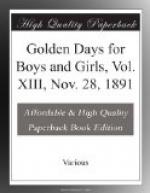This plateau is like a garden, and everything temperate or semi-tropical grows with very little care. Yet Mexico does not figure as a great agricultural country, because, like every other land where nature is kind, man is lazy. Yet the people are picturesque, like all indolent people.
In every hamlet and town the traveler sees stout, handsome men, their dark faces shrouded by great sombreros, the crowns of which come to a point a foot above their heads, and the brims of which seem to be a foot wide all around.
These hats are gorgeous in their silver and gold trimmings. Some of them have ropes of silver around them as thick as your finger.
The clothes below them shine with silver buttons and braid. The pantaloons of some of the men are striped, with silver buckles, while to the waist of each, fastened by a leather belt filled with cartridges, hangs a big silver-mounted revolver.
The lower classes of the men of Mexico dress in cotton, but they wear blankets of all the colors of the rainbow about their shoulders, and they drape these around themselves in a way that adds dignity and grace to their bearing.
The women are as peculiar as the men, though their plumage is less gay. Those of the wealthier classes are dressed in black. In the interior cities of Mexico the better class of women wear no hats, and their heads are either bare or covered with a black shawl, out of which their olive-complexioned faces shine and their dark, lustrous eyes look at you with a strange wonder.
The Indian women are especially picturesque. They often wear dark-blue cottons, and about their heads they drape a cotton shawl or reboso, so that only the upper half of the face shows. Some of them wear bright-red skirts and white waists, and many of them go barefooted.
The future of this great republic is difficult to foresee. At present it is in a transition state, and is not making very rapid progress, according to our ideas. But great results are expected from the railroad which now extends to the City of Mexico.
As the “feeders” are gradually extended on either side it is believed that many abandoned mines will be reopened, new ones discovered and a great impetus given to agriculture and commerce.
Just now, however, the railroad is chiefly of value to the tourist, who can, by its means, visit with ease and comfort a land as strange in many respects as ancient Egypt.
SOMETHING ABOUT COAL-TAR.
by B. SHIPPEN, M.D.
Most people know and dislike the odor of coal-tar, which is distilled from soft or bituminous coal in making gas, as well as in other processes.
It seems to have been first collected by a German, named Stauf, in 1741. Of course there was no question of gas-making then, and the German, who was more of an alchemist than a chemist, was looking for other things than the coal-oil which he obtained.




